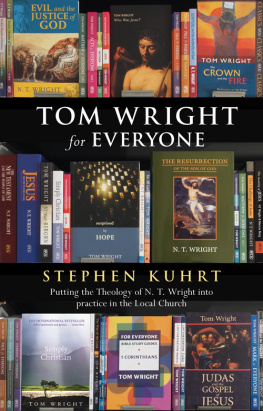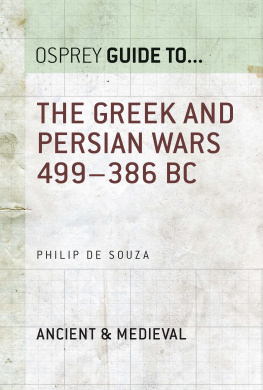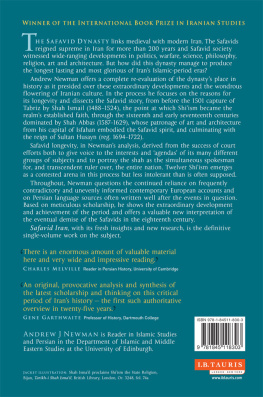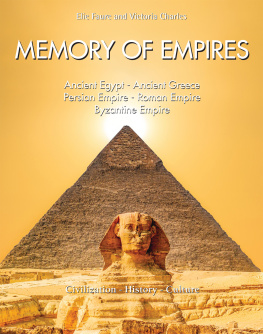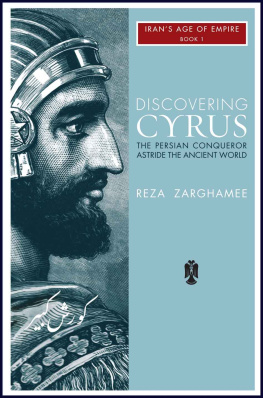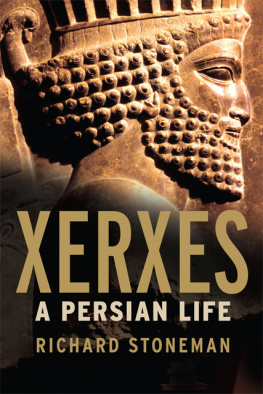Kuhrt - The Persian Empire 1
Here you can read online Kuhrt - The Persian Empire 1 full text of the book (entire story) in english for free. Download pdf and epub, get meaning, cover and reviews about this ebook. City: London, year: 2008, publisher: Taylor & Francis (CAM);Routledge, genre: Art. Description of the work, (preface) as well as reviews are available. Best literature library LitArk.com created for fans of good reading and offers a wide selection of genres:
Romance novel
Science fiction
Adventure
Detective
Science
History
Home and family
Prose
Art
Politics
Computer
Non-fiction
Religion
Business
Children
Humor
Choose a favorite category and find really read worthwhile books. Enjoy immersion in the world of imagination, feel the emotions of the characters or learn something new for yourself, make an fascinating discovery.
The Persian Empire 1: summary, description and annotation
We offer to read an annotation, description, summary or preface (depends on what the author of the book "The Persian Empire 1" wrote himself). If you haven't found the necessary information about the book — write in the comments, we will try to find it.
The Persian Empire 1 — read online for free the complete book (whole text) full work
Below is the text of the book, divided by pages. System saving the place of the last page read, allows you to conveniently read the book "The Persian Empire 1" online for free, without having to search again every time where you left off. Put a bookmark, and you can go to the page where you finished reading at any time.
Font size:
Interval:
Bookmark:
THE PERSIAN EMPIRE
A Corpus of Sources from the Achaemenid Period
This lavish volume contains the most complete collection of raw material for reconstructing the history of the Achaemenid Persian empire in existence.
The Achaemenid dynasty (550330 BC) ruled over the first and largest world empire in history: the Persian empire extended from Central Asia in the east to the Jews and Greeks in the west, with fingers of control in the fringes of the Indian subcontinent and elsewhere. Its sheer size was a factor in its destruction by Alexander the Great, yet long after its dismemberment its influence can be seen in the development of Judaism, the Old Testament of the Bible, and the formation of classical Greece.
Studying Achaemenid history has therefore been difficult in the past because original sources include texts from hugely disparate origins, many different languages and various periods in history; the risk is to rely too heavily on prejudiced and often inaccurate Greek and Roman sources.
Amlie Kuhrt presents here an unprecedented collection of key texts to form a complete and balanced representation of all aspects of the empire, in her own translations from their original Greek, Old Persian, Akkadian, Hebrew, Aramaic, Egyptian or Latin.
Kuhrt selects from classical writers, the Old Testament, royal inscriptions, administrative documents and Babylonian historical writing, as well as examining evidence from archaeological sites. All material is accompanied by a detailed introduction to the sources and guidelines to their interpretation.
A truly monumental achievement, this collection will prove to be the ultimate resource for any student of Persian history, from undergraduate level to the most advanced scholar.
Amlie Kuhrt is an Ancient Historian specialising in the Middle East, particularly the history of Mesopotamia and Iran in the first millennium BC. She is Professor of Ancient Near Eastern History at University College London and fellow of the British Academy.
THE PERSIAN EMPIRE
Amlie Kuhrt

First published 2007
by Routledge
2 Park Square, Milton Park, Abingdon, Oxon OX14 4RN
Simultaneously published in the USA and Canada
by Routledge
711 Third Avenue, New York, NY 10017
First published in paperback in 2010
Routledge is an imprint of the Taylor & Francis Group, an informa business
2007, 2010 Amlie Kuhrt
All rights reserved. No part of this book may be reprinted or reproduced or utilised in any form or by any electronic, mechanical, or other means, now known or hereafter invented, including photocopying and recording, or in any information storage or retrieval system, without permission in writing from the publishers.
British Library Cataloguing in Publication Data
A catalogue record for this book is available from the British Library
Library of Congress Cataloging in Publication Data
A catalog record for this book has been requested
ISBN10: 0415436281 (hbk)
ISBN10: 0415552796 (pbk)
ISBN13: 9780415436281 (hbk)
ISBN13: 9780415552790 (pbk)
CONTENTS
PART I
Prehistory and formation of the empire (c.750520)
PART II
Achaemenid history and its problems
PART III
Kings and kingship
PART IV
Achaemenid imperial organisation
ILLUSTRATIONS
Preface and Acknowledgements
The aim of this book is to provide a guide to the problems involved in trying to reconstruct the history and workings of the Achaemenid Persian empire. Given that much of the material is scattered across academic disciplines, I hope that it may serve as a guide by bringing the most important pieces of evidence together. There are some apparent omissions. I have no chapters devoted to the Persian armies and warfare nor on imperial or provincial administration. The evidence for this is bitty, often embedded in texts on which (our very partial) reconstruction of the political history depends. I hope that the accompanying notes, together with cross-referencing, will help to compensate for this lack.
The introduction to each chapter serves to set out the difficulties involved in using the very disparate sources and so orientate students. In order to reduce the length of the bibliography, I refer the reader for complete references to Pierre Briants book on the Achaemenid empire of 1996, now available in an English translation (2002), which contains detailed research notes. That, together with his annotated bibliographical supplements of 1997 and 2001 (a third is in progress), provides the fullest possible references. In general, I recommend that readers use this book together with Briants work, which is the most authoritative study of all aspects of the Achaemenid empire available. More material pictorial, work in progress, texts, newsletters, recent archaeological work, links to relevant sites such as Encyclopedia Iranica and the Oriental Institute in Chicago, publications online can be found at www.achemenet.com. Another helpful reference tool is the detailed bibliography prepared by Ursula Weber and Josef Wiesehfer, Das Reich der Achaimeniden: eine Bibliographie (AMI Erg. 15), Berlin, 1996. Important studies, relevant to the subject, appear continually, which I have not been able to take into account. For example, a new publication has just come to my notice on the debated term Arya, G. Fussman et al., Aryas, Aryens et Iraniens en Asie centrale (Paris: Institut de Civilisation Indienne, fasc. 72, 2005), which will need to be taken into account in future discussions (see 11, no. 12, n.3; 17, Section B(a)). Another book is the beautifully illustrated introduction to the Achaemenids by Lindsay Allen, The Persian Empire: a history (London: British Museum Press, 2005). Readers should also look out for M. Brosius, The Persians, publication of which is scheduled for 2006 (London: Routledge).
Some technical points. All dates are BC, unless stated otherwise. The abbreviations of Achaemenid royal inscriptions are conventional, established by Kent, and followed by all subsequent scholars. Each inscription presented here is more fully described in the appropriate place, so I have not added these to the list of abbreviations. Where an ancient writer is primarily known for just one work, I have not given the title; thus, I refer simply to Herodotus, not to Herodotus, The Histories. Apart from instances where they are credited, I have (re)translated everything, although inevitably my translations rely heavily on existing ones to which reference is made. Given the many different languages in which the written sources exist, I have not attempted to provide consistent spellings, tending to use the most familiar ones where applicable.
Conventions used: // = sh; // = emphatic s; // = emphatic t ; Akkadian /h/ is always hard, like ch in loch; the same sound is rendered by Egyptian // and OP /x/;// = is like ch in German ich; // = emphatic h; // = dj; // = tj; [] lacuna in text of undefined length; <> error in text restored; () indicates an omitted passage;signals uncertain readings in text. Some Old Persian words have been reconstructed from loanwords in other languages (Aramaic, Elamite and Greek); since they are not attested in OP texts, such reconstructions are usually indicated by an asterisk, e.g. *ganzabara-.
I owe a debt of gratitude to many people and institutions in preparing this book. In particular I should like to thank Lindsay Allen, Pierre Briant, Maria Brosius, Wouter Henkelman and John Tait, for reading, advice and correcting sections of the manuscript; the Leverhulme Trust for granting me a fellowship that freed me from undergraduate teaching, so that I could pursue essential research; and Tessa Rickards for the drawings. I should also like to acknowledge the following for assistance with material: Beatrice Andr-Salvini, Elizabeth Betties, David Brown, Marie-Franoise Clergeau, Dominique Collon, John Curtis, Susan Davies, Margaret Drawer, Geoffrey Emberling, Mark Garrison, Ann Gunter, Tom and Sadie Holland, Charles Jones, Deniz Kaptan, Louis Levine, Carey Martin, Dan Potts, Michael Roaf, Margaret Root, Ursula Seidl, Nicholas Sims-Williams, Harry Smith, Matthew Stolper, Christopher Walker, Susan Walker, Josef Wiesehfer.
Next pageFont size:
Interval:
Bookmark:
Similar books «The Persian Empire 1»
Look at similar books to The Persian Empire 1. We have selected literature similar in name and meaning in the hope of providing readers with more options to find new, interesting, not yet read works.
Discussion, reviews of the book The Persian Empire 1 and just readers' own opinions. Leave your comments, write what you think about the work, its meaning or the main characters. Specify what exactly you liked and what you didn't like, and why you think so.



